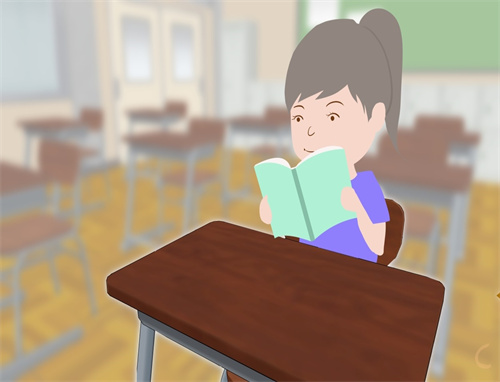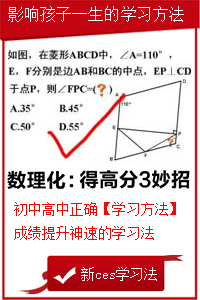句子插入题是托福阅读十大题型之一,从句子层面考察考生对句间逻辑关系、段落大意的理解和把握。下面小编就和大家分享深入解析托福阅读句子插入题,来欣赏一下吧。
深入解析托福阅读句子插入题
掌握衔接词对解答这类问题非常重要,因为它是理解上下文和这个句子的逻辑关系的核心。衔接词语主要包括代词(指示代词,例如this, these their, it, such, another ,这些通常是上文提到过的,所以可以采用就近原则来做。);关键同义词,重复出现的形容词,副词和名词;表示因果,转折等关系的过渡词语:如,therefore, so, however, as a result, consequently, on the contrary, however 等;递进扩展词:如,furthermore, also, as well, too, in addition, moreover, besides, even, additionally等;结构配对词:如,on the one hand…. on the other hand,some…others,同时还要注意一些表示顺序的词,如first ,second ,third等。
我们来具体来一个例子:1. But there is also another special kind of conversational flow among Southern women that contributed to their writing. 2. Some of their talk took the form of tales and vignettes told for their own sake.3. Sometimes humorous, sometimes sad; all were as bright as the figures in the fine needlepoint. 4.
Look at the four positions that indicate where the following sentences can be added to the …paragraph of the passage.
These tales included grotesque, comic, and poetic descriptions, character sketches, narratives, gusts of feeling, delicate ironies, and astute observations.
Click on a position to add the sentence to the passage.
A: position 1 B: Position 2 C: Position 3 D: Position 4
接下来再来看看如何解答这道题。理解要插入的句子,These tales included grotesque, comic, and poetic descriptions, character sketches, and narratives, gusts of feeling, delicate ironies, and astute observations. 我们看这个句子是主、谓、宾结构,其中宾语为一些列的并列名词和短语。寻找衔接词,这个句子的衔接词为:These tales。分析这个句子和上下文的关系:位置1 不可能,因为它后面的句子是一个主题型句子,即,提出论点,而我们要插入的句子为一个小点,属于论据。然后看位置2,这里出现了和我们要加入句子一样的信息点Some of their talk took the form of tales and vignettes told for their own sake。显然句子放在位置2是不行的;位置3后面的句子是对其前面句子for their own sake的进一步解释。所以最后只能是位置4了。把这个句带入各个位置。检查每个位置,位置4是最恰当的。
句子插入题的一个本质和一个原则往往被大家忽略,导致失分很多。一个本质---插入句是一句“可有可无”的话。题的出题位置大家比较清楚,一般处于倒数第二题的位置,并且用来出题的段落是大家应该在前面的题目中已经见到过,而之前的题目和文章既然大家理解起来没有出现大的障碍,就说明插入进来的句子是一句可有可无的话。这就要从两个方面来理解了。
何为“可有”?既然插入句能放进原文中去,就说明它和原文是有一定关系的,所以叫“可有”,这也就意味着,插入句的部分含义是在原文中有所重复的。所以我们的重点是回到文中找那部分被重复的句意。例如:
█Watt's steam engine soon showed what it could do. █It liberated industry fromdependence on running water. █The engine eliminated water in the mines by drivingefficient pumps, which m-ade possible deeper and deeper mining. █The ready availability ofcoal inspired William Murdoch during the 1790s to develop the first new form of nighttimeillumination to be discovered in a mill-ennium and a half. Coal gas rivaled smoky oil lamps andflickering candles, a-nd early in the new century, well-to-do Londoners grew accustomed togaslit houses and even streets. Iron manufacturers, which had starved for fuel while dependingon charcoal, also benefited from ever-increasing supplies of coal: b-last furnaces with steam-powered bellows turned out more iron and steel for the new machinery. Steam became themotive force of the Industrial Revolu-tion as coal and iron ore were the raw materials.
(官方真题Official6-Powering the Industrial Revolution)
Look at the four squares [█] that indicate where the following sentence coul-d be added tothe passage.
The factories did not have to go to the streams when power could come to th-e factories.
Where would the sentence best fit?
在上题中,“liberated industry from dependence on running water”和 “The factories did not have to go to the streams”句意便发生了重合。所以我们可以确定,文中第二句话的前后应该是我们可以选择的范围。
何为“可无”?这个便是经常被大家忽略的地方。既然这句话,可以省略,那么这个插入句究竟要符合什么特点呢?还是以上题为例,我们发现 “liberated industry from dependence on running water”和 “The factories didnot have to go to the streams”句意发生了重合,那究竟应该把插入句放在第二个█还是第三个█呢?这时就需要分情况讨论了:
情况1:放在第二个█,也就是说我们认为插入句是和下文有关系,既然要符合“可无”这个本质,所以说插入句必须是对下文概括或者引出。
情况2:放在第三个█,也就是说我们认为插入句是和上文有关系,既然要符合“可无”这个本质,所以说插入句必须是对上文进一步解释。
综合以上两种情况,我们会发现,插入句要么总结引出下文,要么进一步解释上文。所以我们会发现,在插入题中,前一句的叙述范围应该总比后一句大。 根据上述内容,也就引出了我们需要注意的一个非常重要的做题原则。
一个原则。在插入题中,句子的叙述顺序遵循从大到小,从抽象到具体的原则。找到重复的句意后,按照大小顺序安置插入句的位置。在上题中,“liberated industry from dependence on running water”的意思是解放了工厂对水流的依赖。 “The factories did not have to go to the streams”的意思是工厂不用去往河流的位置。显然前者说得更概括和抽象,后者更具体,所以按照从大到小的顺序,应该选择第二个█。
托福阅读:基本题型
要点:
an academic environment---越来越偏向于学术的讨论,越来越像IELTS的Academic类考试
reading---a variety of different subjects
passages---3 different categories based on author purpose:
1. Exposition
2. Argumentation
3. Historical
你需要了解general organization of the passage
.classification
.comparison/contrast
.cause/effect
.problem/solution
每篇阅读的平均字数是700, 当然根据考试的实际情况,可多可少
iBT的阅读有10种题型,下面我们一种一种的来回顾:
经验:
第1、5种题型,占的分量最多,难度也不大,要保证一个也不错
第9种和第10种题目,难度最大,想取得高分,必须要多做综合练习
剩下的题型也很重要,想取得高分,一个都不能少
1. Factual Information Questions
这样的题目,一般来说mentioned only in part of the passage. 答题的信息就在段落的1,2句话中。
技巧:你不可能在第一遍阅读的时候,就找到正确答案,需要看题目以后,回头再找;排出那些本身就很矛盾的选项;千万不要因为你看这某个单词或者句子在段落中出现过,就选择那个选项,一定要回答问题。
2. Negative Factual Information Questions
做这样的题目,你首先需要对定位:locate the relevant info. in the passage
注意:这种问题你要选择的正确答案, 是那个不正确的,问题里面会明确的指出:which one is NOT true
技巧:选项里面的答案,可能叙述了一段的意思,也可能叙述了好几段
正确的那个答案,要么是直接和文章的意思矛盾,要么是文章里面没有提到的。
3. Inference Questions
注意的字眼,是infer, imply, inferred
技巧: 正确的答案,必须是从文章已给内容推出的,特别注意
4. Rhetorical Purpose Questions
Rhetorical is the art of speaking or writing effectively.
他不关心作者说了什么,关心的是作者为什么要这样说
技巧: 注意字眼definintion, example, to illustrate, to explain, to contrast, to refute, to note, to criticize, function of
这样的题目尤其会侧重句子还有段落之间的逻辑联系
5. Vocabulary Questions
大家不要太在意这个单词在字典里面什么意思,最重要的是,这个单词在文章里面的意思:in the reading passage, only one of the meanings of a work is relevant
技巧:问题是问你单词在文章里面的意思,再次强调
6. Reference Questions
这样的问题,主要是问你代词指代的内容是什么[根据我观察的经验,代词指代的东西,一般来说就在你这个代词的前面,或者隔了1个短语,不会太远:...AAAAA, BBB, CCC, X.X.X...一般来说, X.X.X不是指代C就是指代B,不会跑太远。
技巧:代词, pronoun, 在选择以后,检查答案的时候,一定要注意一致性:the same number: singular or plural; case: first person, second person, third person
当你选择了答案以后,你的选择会不会违反语法原则,并且会不会有意义
7. Sentence Simplification Questions
并不是每一篇文章都有这样的题目,如果有,一篇文章最多只有1个
8. Insert Text Questions
不是每篇阅读都有这样的题目,如果有,一篇文章最多只有1个
技巧:从文章结构下手, structure; 从逻辑下手, logic
尤其注意逻辑的链接单词和语句, 例子:on the other hand, for example, on the contrary, similiary, in contrast, further or furthermore, therefore, in other words, as a resule, finally一定要注意,你插入的语句,一定要承上启下,即对前面的语句负责,又对后面的语句负责。
新托福,总要有他新的地方,阅读方面,第9, 第10种类型的题目,就是他新颖的地方,也是比较难的2种题目。
9. Prose Summary Questions
正确的答案, will synthesize major ideas in the passage
你将会碰到6选3的情况, 最低得分0分,最高得分2分:选择0正确答案,或者1个正确答案,0分;选择2个正确答案,1分;选择3个所有的正确答案,2分。
做这种归纳的题目,最重要的是,你要通篇的阅读,不能偷懒。
根据我的经验, 技巧有2点:1.区别例子和主旨, 例子是用来说明主旨的,例子不是主旨; 2. 局限性的答案一定是错误的, 主旨是让你找到major oint, 千万不要让minor给迷惑了。
10. Fill in a Table Questions
这种题目,就是题目给了你几个空,让你把正确的答案拖到相应的位置,需要通篇阅读,不简单。
关键是你要明白几种关系:cause-effect relationships, compare-contrast relationships, arguements, and the like.
也可以称作文章的组织关系,types of organization: compare/contrast, problem/solution, cause/effect, alternative arguements(such as theories, hypotheses), and the like
在真实考试的时候:drag your answer choices to the spaces where they belong. to view the passage, click on View Text.
知道这10个题目的类型,剩下的就是方法论,methodoly的问题,我们怎样针对这10种题型,在平时的学习和阅读当中,可以的训练自己:
主旨:最好的培养阅读的方法,就是多去阅读,而且要阅读各种不同题材的文章,科学的,社科类的, 艺术的,商务的,等等。还有一点需要特别强调的,就是阅读的那些文章,需要是学术的文章,不能是乱七八糟的随笔。
托福阅读:重要的背景知识
一、印第安题材
1.白令海峡移民理论
2.印第安文化
3.印第安宗教观
4.印第安建筑业:大、先进。
5.印第安手工业:好。
6.社会组织结构:严密、分工细、凝聚力强。
7.农业先进:A. irrigation; B. maize, squash, bean, pea。
二、动植物题材(必考)
1.植物学题材(不多见)
a. 地衣、苔 、真菌、蘑菇最常见。
b. 树冠上方生物。
c. 植物在生态平衡中的作用。
2.动物学题材(90%以上)
a. 考普通动物为多。最近常考鸟类、蚂蚁、动物智能与灭绝(联系天文学与冰河理论)。
b. 考动物进化(evolution)。
c. 考动物的分类(classification)。
phyla(单数phylum) —门 class—纲 order—目 family—科 genus—属 species—种 carnivore/predator—食肉动物 herbivore—食草动物 omnivore—杂食动物
d. 动物的生活习性最为多见。
群居(social animal)动物的习性
a) 蚂蚁:社会组织结构—等级制(caste):交流方式—信息素—气味;生活来源;外来物种的有害性。
b) 蜜蜂:群居个性; “8”字舞;蜜蜂智能;防御;天敌—大黄蜂。
c) 大猩猩:智能:猩际关系
k) 迁徙 (migration )
野鸭、大雁:日照长短;辨别方向。
伪装 (camouflage)、花拟态(mimicry )
三、考古学(archaeology)题材
1.文化(cultural ) 考古学
形态(physical)考古学(多见)
2.化石(fossil )
j 化石构成。化石比原物更沉重 (矿物质环境)
k 化石形成原因。 坚硬物质,迅速掩埋。
l 化石与动物的进化关系。
3.人的左右手
j 使用工具。 证据:敲击的划痕;手柄的形状。
k 牙齿上的划痕。
l 大脑左右半球的大小差别;趾骨的粗细差别。
m 作画时人像的方向
4.古代陶瓷的考古。
Clay, model, wheel (转盘 ), glaze, kiln
5.古代文字的考古。
四、美国历史题材
1.美国发展线索
j 发现美洲阶段
哥伦布(意),为黄金、茶叶、香料
West/East Indian
影响:世界观变化;国家形势变化;(爱尔兰——土豆饥荒 )
k 英国定居阶段(English settlement )
1607第一个定居点Captain John Smith影响清教徒
1620五月花号
l 殖民时期(colonial era )
m 独立战争(American Revolution )
n 新的国家(new nation):南北不均衡
o 南北战争(Civil War )
p 战后重建。 持续近100年。
q 西进运动 (Westward movement )
r 工业化大增长
s world war I & II
End :1960
2.“大熔炉”:地理位置;民族融合1960’s;文化融合。
3.邮政。j 快递;k 铁路邮政。
五、地理学题材
1.地理现象、土壤构成、降雪降雨。
2.冰川(glacier)、形成(foundation) à移动冰川(surge glacier )à危险
3.地球构成:地心构成
M计划、 DSDP(deep sea drill project )计划、地震波探测à 超高温高压
地壳 (crust)
地幔(mantle ) upper mantle; lower mantle
地核 (core)
4.板块构成学说
converge 碰撞; spread 张裂
mantle plume 地粒 、热点; a dive into b ; slide past each other
六、天文学题材
多考木星、太阳,近期多考彗星、小行星。
1.宇宙 (universe、cosmos) à 星系(galaxy ),星云(nebulae) à 恒星 (star、sun ) à 行星 (planet)à卫星 (satellite、moon )à 小行星(asteroid à 彗星(comet ) à陨星 (meteorite)
2.八大行星
Mercury —水星,Venus—金星,earth—地球, Mars—火星,Jupiter —木星,Saturn —土星,Uranus —天王星,Neptune — 海王星(第九大行星Pluto —-冥王星已被天文学界逐出行星之列)
3.物质粒子
molecule —分子,particle —粒子,proton—质子,electron —电子, neutron —中子,photon —光子,ion —离子
7.文学、艺术题材
1.文学
j 文学流派;k 作家、作品; l 文学体裁; m 作家生平。
2.艺术
j 流派, 主考画派、雕塑
k 发展:19世界以前美国落后,之后改善原因:经济发达。
l 改善方法:向欧洲, 尤其是英法学习。
m 艺术品向英法进口:当地没有; 生产技术水平落后。
托福阅读相关文章:
★ 学习资料库
★ 英语阅读
★ 学习资料库
★ 大学英语学习计划书
★ 托福听力7大类关键信号词全面讲解
★ 托福改革后首考落幕 新增“托福移动考点”
★ 托福阅读备考5个步骤分享
★ 托福阅读句子插入题解题本质原则讲解
★ 短期内提升托福听说读写的方法
★ 托福阅读解题有没有技巧怎么办
深入解析托福阅读句子插入题
上一篇:三步走教你拆分托福阅读长难句
下一篇:托福阅读中能读懂却做错现象解答






